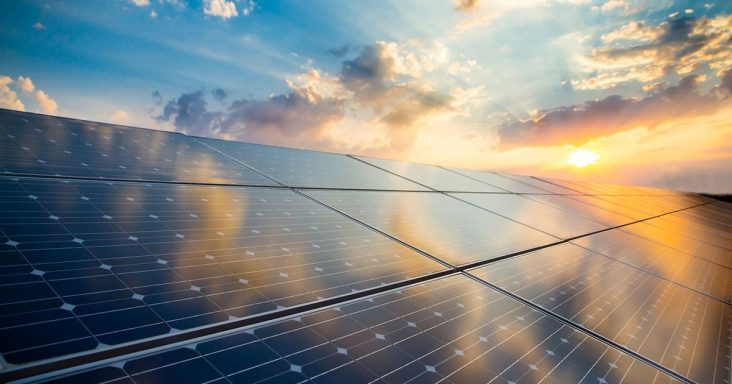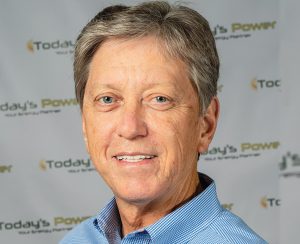One-on-one with Today’s Power Inc. CEO Michael Henderson
by December 10, 2020 8:00 am 1,098 views

Solar energy is on the rise in Arkansas and around the nation. Commercial and residential solar capacity is hitting new highs and solar panel production eclipsed a new record in 2019. For 2020, those milestones are expected to climb to higher levels.
Michael Henderson, who just left his post as CFO of the Arkansas Electric Cooperative Corp. (AECC), will go full-time as CEO of solar power installer, Today’s Power Inc. A subsidiary of AECC, Today’s Power is owned by 17 Arkansas electric distribution cooperatives and has been prolific with contracts and new business over the past two years.
Henderson discussed the future of solar energy with Talk Business & Politics Editor-in-Chief Roby Brock.
TB&P: Today’s Power has been in major growth mode for several years, but especially this year, and 2021 looks pretty promising. What is driving interest in solar right now?
Michael Henderson: There are two camps driving solar interest: Economics and environmental stewardship. From an economics driver, a lot of cost factors have aligned to result in significantly lower costs. Solar components’ prices have fallen, Investment Tax Credit incentives provide cost reductions, and financing costs are at record lows. All of these add up to really low electricity costs. From an environmental stewardship driver, many corporations have mandates to attain certain emission levels at their facilities because their customers require it. Corporations like Walmart and Tyson Foods have strong multi-level sustainability programs and solar is one way to help meet those goals. Other industries such as agriculture have always been good stewards of the land and just want to do the right thing and solar is just another way to accomplish that. Why is everyone hungry for this option? I think the simplicity of solar and the fact that it can be a local resource makes the public seek it because they can see it, watch it produce, and understand the savings.
TB&P: What investments have you all made to position yourself for this rapid growth?
Henderson: TPI has taken steps during 2020 to position for growth by acquiring a new headquarters facility to allow employees to focus specifically on TPI growth. We developed a system monitoring & operation center to be able to know at any given moment how each facility is producing. We have invested in people who are the best at what they do so our customers get the absolute best service. Lastly, we have invested in relationships with vendors, bankers, agencies, etc. that allow TPI access to resources to allow its growth.
TB&P: Are you fearful that you could grow too much, too fast or is the planning portion of this manageable?
Henderson: I am fearful of the rate of growth primarily because I come from a utility background where we have the luxury to study a decision for six months before making a decision. The TPI world consists of expiring Income Tax Credits and the threat of rising interest rates which necessitates moving quickly. Having financing in place, a talented team, and the ability to secure product makes growth manageable.
TB&P: Every time I turn around, you or a competitor announce a new project. How much potential is there in this space?

Henderson: The potential is huge for those who understand the electricity market and the corporate culture. With my financial background, manufacturing experience and utility knowledge, I feel TPI is uniquely positioned to develop solutions to meet every customers needs. TPI can tell a customer what configuration saves the most for them or if they won’t save from solar at all. Arkansas has some very attractive electric rates and everyone may not benefit from installing a solar system. However, with the advent of lower cost solar and lower cost reliable storage systems, it is easier for most customers to be able to realize savings.
One example is the General Dynamics solar system that was installed this month and in conjunction with that we installed storage twice the size of the solar, which means if that facility loses grid electricity, it will be able to continue its manufacturing process without losing work in progress. This added resiliency makes General Dynamics a more reliable supplier to the Department of Defense which has value.
There is huge potential in the electric vehicle infrastructure market. I recently began driving an electric vehicle and the need for fast-charging infrastructure is huge. Arkansas has very minimal existing fast-charging systems.
TB&P: The projects now are larger scale and primarily industrial or agricultural. Is that the space you plan to stay in?
Henderson: Our goal is to help our customers save money on their energy bills. Larger systems result in lower costs. We are developing several solar parks where smaller customers aggregate their solar systems to produce a larger resource in coordination with the local utility. We generally add storage at these sites, which helps local utilities manage their loads for reliability and additional economic savings.
The large 100-MW systems are lower cost on a MW basis, however, they are still dependent on transmission and distribution infrastructure. Our focus is on installing local point of consumption systems, or micro-grids, that can avoid transmission costs that are not needed.
TB&P: Is there the possibility for smaller scale solar and what might that look like?
Henderson: TPI definitely does smaller systems as well. This is the Wild, Wild West because consumers are told a lot of mis-represented data to encourage them to buy their solar system. We have seen systems sold to people who end up paying more for their solar and utility than their original utility or people being sold solar systems with a 15-year payback, yet the person’s life expectancy is much lower than that. TPI tries to make prudent recommendations that’s in the best interest of the customer.
